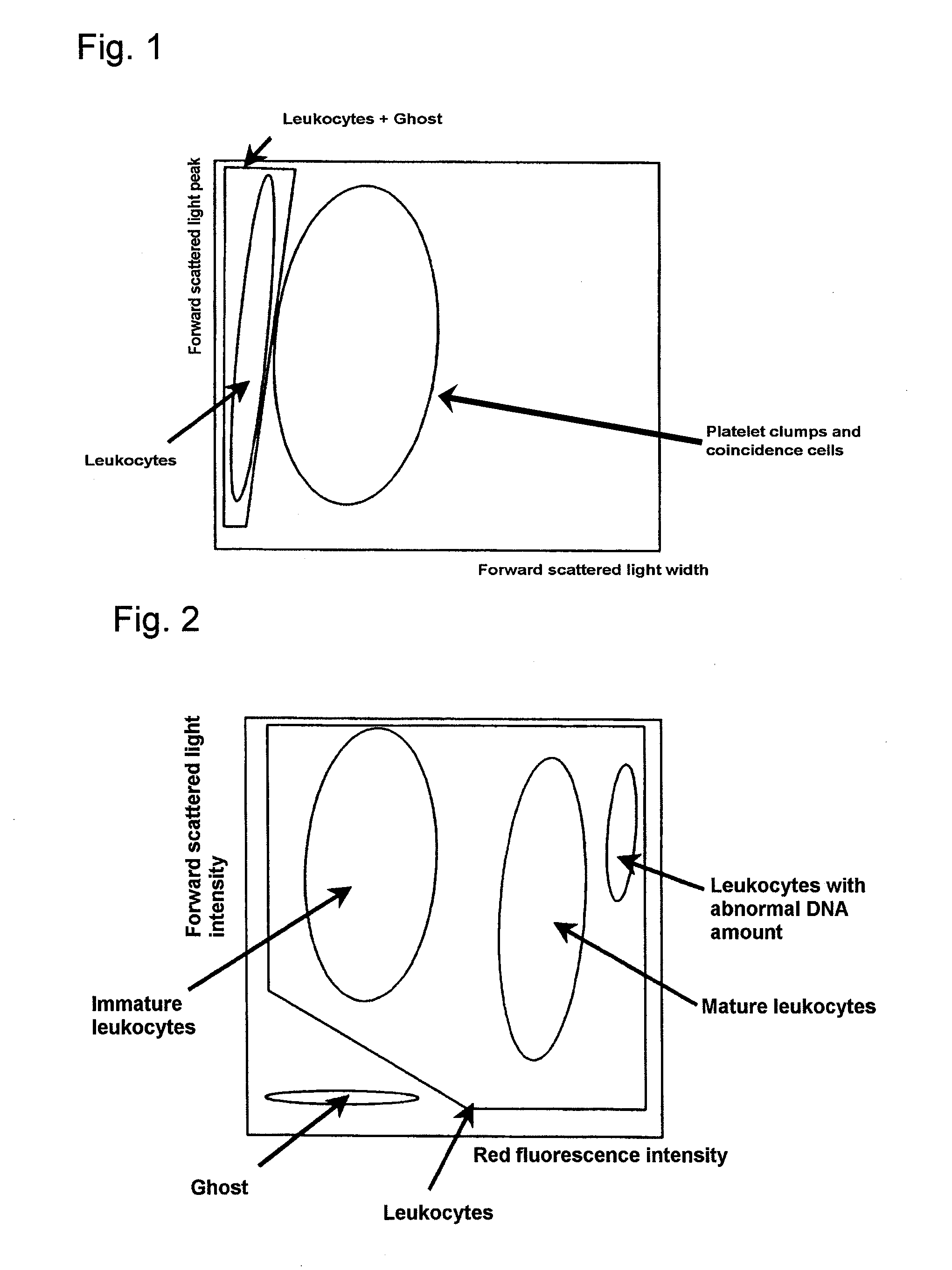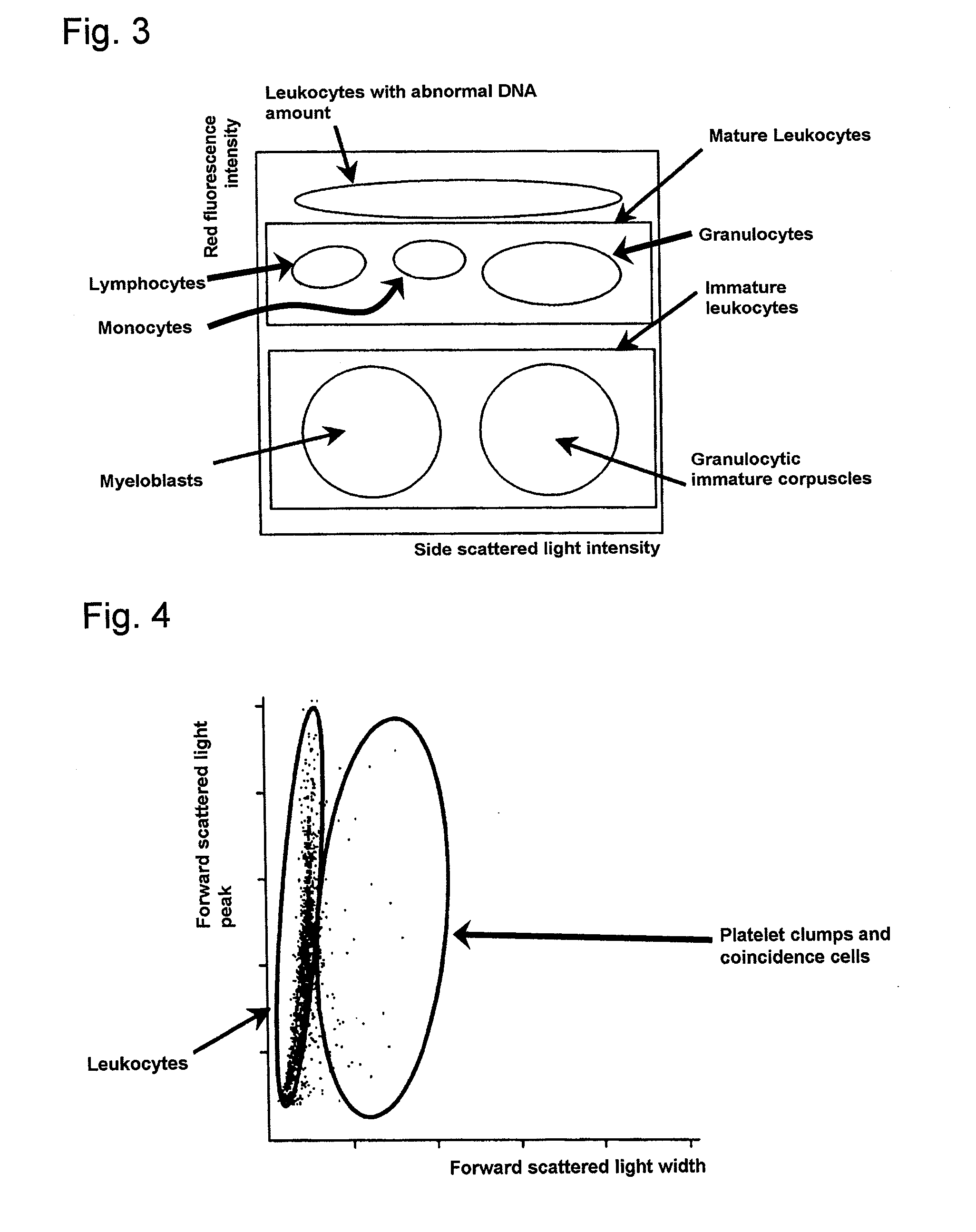Method of classifying and counting leucocytes
a leukocyte and counting technology, applied in the field of classifying and counting leukocytes, can solve the problems of complex separation of mononuclear leukocytes by specific gravity centrifugation, inability to precisely detect and classify immature leukocytes, and inability to differentiate leukocytes
- Summary
- Abstract
- Description
- Claims
- Application Information
AI Technical Summary
Benefits of technology
Problems solved by technology
Method used
Image
Examples
example 1
[0084]A reagent comprising an aqueous solution of the following composition was prepared.
(The Present Method)
[0085]
Polyoxyethylene(16)oleyl ether24.0gSodium N-lauroylsarcosinate1.5gDL-Methionine20.0g1 N-NaOH0.3gNaCl4.0gDye of formula (VI)3.0mgHEPES12.0gPure water1000ml
[0086]The above-mentioned reagent (1 ml) was mixed with 33 μl of blood collected from a patient suffering from lymphoid leukemia, and after a lapse of 10 seconds, forward low angle scattered light, side scattered light, and red fluorescence were measured with a flow cytometer (light source: red semiconductor laser, wavelength: 633 nm).
(A Standard Method for Measurement of the DNA Amount)
[0087]
Trisodium citrate100mgTriton X-100 (Wako Pure Chemical Industries, Ltd.)0.2gPropidium iodide (Sigma)0.2gRO water100ml
[0088]The above-mentioned reagent (1 ml) was mixed with 100 μl of blood collected from the above-mentioned patient, and after a lapse of 30 minutes, red fluorescence was measured with a flow cytometer (light source:...
example 2
[0092]A reagent comprising an aqueous solution of the following composition was prepared.
(The Present Method)
[0093]
Polyoxyethylene(16)oleyl ether24.0gSodium N-lauroylsarcosinate1.5gDL-Methionine20.0g1 N-NaOH0.3gNaCl4.0gDye of formula (VII)3.0mgHEPES12.0gPure water1000ml
[0094]The above-mentioned reagent (1 ml) was mixed with 33 μl of blood collected from a patient suffering from acute myelocytic leukemia (AML), and after a lapse of 10 seconds, forward low angle scattered light, side scattered light, and red fluorescence were measured with a flow cytometer (light source: red semiconductor laser, wavelength: 633 nm).
(A Standard Method for Measurement of the DNA Amount)
[0095]
Trisodium citrate100mgTriton X-100 (Wako Pure Chemical Industries, Ltd.)0.2gPropidium iodide (Sigma)0.2gRO water100ml
[0096]The above-mentioned reagent (1 ml) was mixed with 100 μl of blood collected from the above-mentioned patient, and after a lapse of 30 minutes, red fluorescence was measured with a flow cytometer...
example 3
[0100]The reagents with the same composition as in Example 1 were used. The reagent of the present method (1 ml) was mixed with 33 μl of bone marrow fluid collected from a patient suffering from osteomyelodysplasia syndrome, and after a lapse of 7 seconds and 13 seconds, forward low angle scattered light, side scattered light, and red fluorescence were measured with a flow cytometer (light source: red semiconductor laser, wavelength: 633 nm).
(A Standard Method for Measurement of the DNA Amount)
[0101]The reagent (1 ml) for the standard method for measurement of the DNA amount was mixed with 100 μl of bone marrow fluid collected from the above-mentioned patient, and after a lapse of 30 minutes, red fluorescence was measured with a flow cytometer (light source: argon ion laser, wavelength: 488 nm).
[0102]The results are shown in a scattergram (FIG. 11) for the case of 7 seconds of the reaction time in which the X-axis indicates the forward low angle scattered light width and the Y-axis ...
PUM
| Property | Measurement | Unit |
|---|---|---|
| fluorescence | aaaaa | aaaaa |
| fluorescence intensities | aaaaa | aaaaa |
| width | aaaaa | aaaaa |
Abstract
Description
Claims
Application Information
 Login to View More
Login to View More - R&D
- Intellectual Property
- Life Sciences
- Materials
- Tech Scout
- Unparalleled Data Quality
- Higher Quality Content
- 60% Fewer Hallucinations
Browse by: Latest US Patents, China's latest patents, Technical Efficacy Thesaurus, Application Domain, Technology Topic, Popular Technical Reports.
© 2025 PatSnap. All rights reserved.Legal|Privacy policy|Modern Slavery Act Transparency Statement|Sitemap|About US| Contact US: help@patsnap.com



